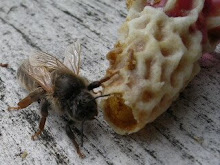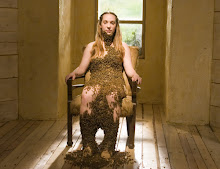So, let me suggest some things:
1. The ONLY possible reason for the "strange" comb is improper spacing of the frames. When using foundation, you should run 10 frames. Only in the 2nd year should you reduce to 9 frames. When running 10, the frames are pretty much self spacing. With 9 frames, you must be VERY VERY diligent about spacing. Some beekeepers always run 10. The problem is that by the 2nd year, it becomes very difficult to remove the frames. Burr comb on top of the frames is also caused by improper spacing but is almost impossible to control. A box that is 1/16 to tall and a frame that sits 1/16 too high will result in burr comb.
2. A failing queen is characterized by an inconsistent brood pattern OR an excess of drone brood. In other words, a healthy queen will fill the frame with few open cells. A failing queen will have many open cells in a checkerboard pattern. An excess of drone brood means she is running out of semen. (However, in the midst of a honey flow, a healthy queen may lay a spotty pattern because she has a hard time finding open cells with all the nectar coming in.)
3. The most likely cause of the difference between your hives is "drift" in the original installation. Because the number of bees grows in an exponential increase, a small difference in the number of bees will make a huge difference later. If 10% of the bees drifted from the weak hive to the stronger in the first few days after installation, the starting point would be 90% and 110%. Do the math and within 8 weeks or so, the stronger hive will have twice the bees. In the first few days after installation, the bees are confused about where their home is. Wind and other factors can cause drift.
4. To boost the strength of a hive, pull a frame of sealed brood from a strong hive, bang it on its end in front of the entrance in order to knock off the bees, and place the frame of brood in the middle of the brood cluster of the weak hive. With packages, you should wait until you are sure the queen is released and accepted before doing this. If you have existing hives (from last year) pull from them to boost the packages as soon as possible. If you only have packages, wait until there is sealed brood. (You don't have to use sealed brood but it is better because the bees hatch sooner.) You may want to pull more than one frame and may have to do this several weeks in a row. In any case, in early spring, try to "equalize" your hives. This overcomes the problem of drift.
5. As for killing a queen, every beekeeper does it once. I will never do it again. If necessary, I let the bees do it. They know best.






4 comments:
thanks for these informative messages Craig.
I am definately queenless right now- and for the last 2 1/2 weeks. The last weekend of June, there were cells with capped brood, and one healthy and robust queen cell that was open. She must have been out on her mating flight I assume. Yesterday I checked the hive; there were no eggs and no brood of anykind when I went through the boxes. Is your suggestion to requeen from a package or add a queen cell, or add a frame of eggs/brood (ANYONE HAVE A QUEEN CELL OR HATCHING QUEEN AVAILABLE ASAP)? Dave can get me one next week which I may wait for, but I am afraid the workers may start laying drones here soon. The hive was loud for the first time yesterday- noticably so! They are still collecting nectar and building frame, although slowly I would say in comparison to weeks ago.
Suggestions welcome.
I have not had good luck dealing with Q/L hives. Especially this late in the season, I doubt it will recover unless it is very strong. I would double it up with a swarm or another hive. Keep the queenright hive on the bottom and the Q/L hive above the newspaper. See my post above.
I'm combining a weak queenright hive this evening and will let you know how it goes! thanks and fingers crossed...
Kim
Thanks for your insights, Craig. I thought I should respond with some additional comments on our thoughts and observations that led to our decision to re-queen.
1. We have 10 frames in all of our hive bodies and supers. In spite of proper spacing, the bees built comb on one side of the foundation, building comb that filled the space for the adjacent foundation and in some cases actually doubling back on itself. They didn't do this on every frame, but there were some very strange arrangements. We did leave the queen cage in too long when we originally populated the hive, but the strange comb building wasn't limited to the two frames that originally surrounded the queen frame.
2. The decision to re-queen was based largely on the exact circumstances Craig describes in item 2. The low population we observed was a reflection of the very poor brood pattern on the frames--low density and widely scattered. Reading and talking to other beekeepers, the advice we found said that bad queens never get better. We were also aware of the passive (let the bee's replace their own queen) v. active management options. We opened the hive to poll the bees and found some drones in one corner of the hive busy at work on a miniature guillotine. Before things got out of hand, we decided to intervene...
3. The prevailing wind pattern in our apiary (can you call 2 hives an apiary?) encourages drift towards the weaker hive. Also, when we started these hives there were significantly more dead bees in the box used for the "strong" hive than the one that would become the "weak" hive. Assuming roughly the same number of bees in a box, the strong hive started from a disadvantage and quickly outgrew the weak hive, with or without drift.
4. I agree that moving bees from a strong to a weak hive can be useful, but is of arguable virtue in our case. It certainly wouldn't have made the queen any more competent, and might have delayed the hive's own instinct to replace their marginal queen.
I checked the re-queened hive this past Saturday, a week after combining the hive with the starter nuc we created with the new queen. In contrast to the original queen's work, the current brood pattern is beautiful--looks like a text book picture. The new queen was on the second frame I pulled and she's laying a lot of eggs. I am confident we made the right decision. Whether the re-queened hive will be able to catch up to our strong hive this late in the season is another question. But I am more confident that the hive will be strong enough to make it through the winter, which was my first concern.
Don (& Mary)
Post a Comment